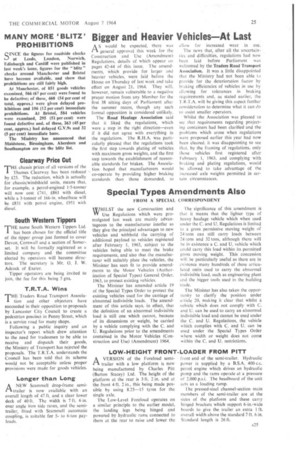Special Types Amendments Also
Page 27

If you've noticed an error in this article please click here to report it so we can fix it.
FROM A SPECIAL CORRESPONDENT
WHILST the new Construction and " Use Regulations which were promulgated last week arc mainly advantageous to the manufacturer insofar as they give the principal advantages to new vehicles and withhold the carrying of additional payload to vehicles registered after February 1, 1963, subject to the vehicles being able to meet the brake requirements, and also that the manufacturer will suitably plate the vehicles, the Minister has seen fit to provide amendments to the Motor Vehicles (Authorization of Special Types) General Order, 1963, to protect existing vehicles.
The Minister has amended article 19 of the Special Types Order to protect the existing vehicles used for the carriage of abnormal indivisible loads. The amendment of this article says, in effect, that the definition of an abnormal indivisible load is still one which cannot, because of its dimensions or weight, be carried by a vehicle complying with the C. and U. Regulations prior to the amendments contained in the Motor Vehicles (Construction and Use) (Amendment) 1964. The significance of this amendment is that it means that the lighter type of heavy haulage vehicle which when used under the C. and U. Regulations is limited to a gross permissive moving weight of 24 tons can still carry loads between 24 tons and 32 tons, although there will be in existence a C. and U. vehicle which could carry this load within its permitted gross moving weight. This concession will be particularly useful as there are in existence many hundreds of these articulated units used to carry the abnormal indivisible load, such as engineering plant and the bigger tools used in the building trade.
The Minister has also taken the opportunity to clarify the position under article 20, making it clear that whilst a vehicle which does not comply with C. and U. can be used to carry an abnormal indivisible load and cannot be used under the C. and U. Regulations, the vehicle which complies with C. and U. can be used under the Special Types Order where width or weight does not come within the C. and U. restrictions.
























































































































